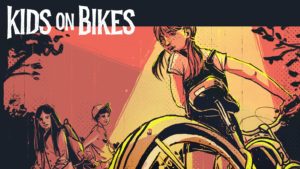What makes our town famous? Why is it notorious? What rumors have you heard? How do you know each other? With these questions you create your world together and then the game begins. Kids on Bikes is a roleplaying game which relies as much on storytelling and creative input as it does on the results of die rolls. You will play as the children, teens or adults of a small town any time before the technology to connect with the world became pocket-sized. You will share rumors, look into your town’s many mysteries and tell stories of your adventures together.
The basic book contains no pre-built towns or setting guidance (though a deluxe edition also exists). Because the collaborative set-up is so important to the game, most of the book is the questions lists and rules for conflicts. As slim as it is, the book is perhaps over-full in that respect, giving a reader more than they really need to get started. Because of the complexity of the creation process for the town and the players’ relationships with each other, this book might be out of reach of the average middle grades reader. The book is attractively illustrated throughout with art in a comic book style. Horror elements can be introduced freely and treated as cartoony (it was just a bird trapped in the attic), or pulpy (there really is buried pirate treasure), or disturbing (one person is sacrificed at the end of the harvest festival) as the players see fit.
Despite the set up being a deliberate journey of many small steps, the actual game play is simple compared to most other RPGs. Anyone who knows what a d20 is and what “exploding dice” mean can run the game. These terms are explained, but a first-time roleplayer may struggle with these concepts. There are 6 stats, no skills, very limited bonuses, and no character death. Most actions a character attempts require a roll. Normal success is a 10 on the die, which is obviously easier on a d12 than on a d4. With at least one experienced roleplayer to help the rules go smoothly, the other players do not need much other than an imagination. No matter if the roll is a success or failure, each player gets to help tell the story of what their action looks like. With some allowance, anyone down to upper elementary can play the game.
One last thing to consider about Kids on Bikes: The allure of a “lost world of the past” is an important part of the game. It works great if all the players actually lived in the time they are re-creating. Nostalgia for the 1980s is a current trend, and this game is part of that trend. With younger players who don’t remember a time before smart phones, the tropes the game in part relies on will not come as easily. Even so, as a storytelling system Kids on Bikes would work well in almost any time and place, even a modern one, as long as the players agree on a similar reference point.
Gameplay requires one player to act as game master, at least one set of standard polyhedral dice (d4, d6, d8, d10, d12, d20), tokens for tracking Adversity and Psychic Energy, character sheets printed from the book (though the sheet is simple enough to make your own on regular paper) and the addition of two-digit numbers.
Reviewed by Matthew Orr.
